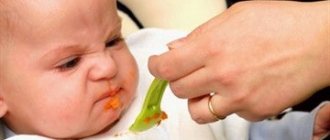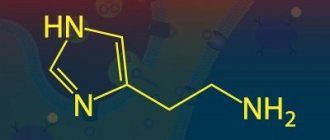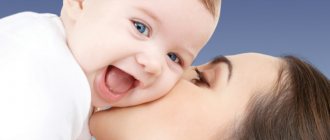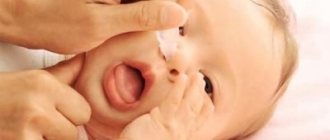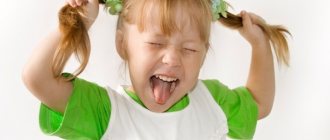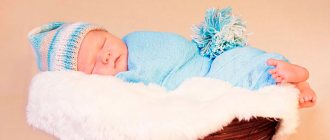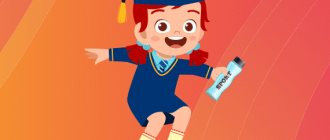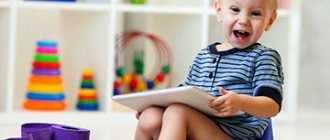How to properly brush children's teeth?
In order for the process of brushing teeth to bring positive moments and, undoubtedly, benefits to the child, several rules should be followed, namely:
- You can’t brush your teeth when your baby is in a bad mood, nothing good will come of it, only the negativity that the child will experience will push him away from this activity for a long time.
- Maintaining hygiene. Before brushing your child’s teeth, the brush must be rinsed first under hot water, then under cold running water.
- The upper teeth are brushed from top to bottom, the lower teeth from bottom to top, and the side teeth in a circle. The inside of the teeth is brushed at an angle.
- For up to a year, you can clean your mouth with gauze soaked in saline solution wrapped around your finger.
- Don’t forget about tongue hygiene, because plaque accumulates on it, promoting the proliferation of a conditionally pathogenic environment. Plaque on the tongue can be cleaned with gauze or with a brush in a circular motion, the main thing is to do this very carefully.
- At the end of cleaning, you can offer your baby a brush to try on his own; this will certainly involve him in the process, and he will wait for his turn every time.
- A brush with bristles should be replaced every five months, even if it looks almost new.
How to care for baby teeth?
| METHODS | DESCRIPTION |
| Brush your teeth twice a day | Ideally, this should be done in the morning and evening after dinner. |
| Make light circular movements | Use a thin layer of toothpaste that covers about 3/4 of the bristles. Use light and small circular movements and focus on the areas where the teeth and gums meet. Never use excessive force when cleaning as this may cause pain to the child. |
| Spitting | Teach your baby to spit out the remaining toothpaste after brushing, but not to rinse his mouth, so that the paste is more effective. |
| Turn the child in the opposite direction from you | The easiest way to reach all the teeth is if the child is sitting on your lap and his head is turned away from you. |
| Let your child hold the brush | If your baby holds the brush, this will allow him to feel some control over the process. You can even let him brush his teeth on his own under your supervision. |
| Brush your teeth before your child | When you brush your teeth in front of your baby, you set an example and teach him hygiene. |
| Talk to your dentist | If you need more information about brushing baby teeth, you can get it from your dentist. |
You can also read the opinions of the popular pediatrician, Dr. Komarovsky, about when you should start brushing your baby’s teeth:
Toothbrushes for children
“Training” toothbrushes are suitable for cleaning children’s first baby teeth. They are equipped with soft bristles, a miniature head and a non-slip, comfortable handle, making them ideal for children under one year old.
And with the help of special massage brushes you can facilitate the eruption of new baby teeth. These bristles pleasantly massage the gums and, in addition, clean the oral cavity.
Short bristles are good for first baby teeth. If all of your baby teeth have popped out, it’s time to use brushes with longer bristles.
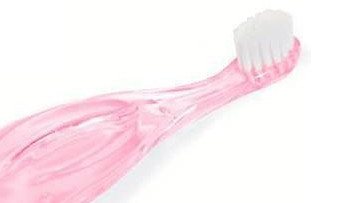
The optimal duration of brushing your teeth is 3 minutes. Children are still poorly oriented in time. Well, toothbrush manufacturers have provided for this too. Some toothbrushes come with an hourglass that lasts for the treasured three minutes.
Electric toothbrushes are recommended for children aged three years and older. When choosing such a brush, parents should be guided by the manufacturer's data. However, it is recommended to use a regular toothbrush along with an electric toothbrush, because only with such a brush will children truly master the skill of brushing their teeth.

From about 8 years of age, children can brush their teeth with adult brushes.
How to brush the teeth of a child under 1 year old
Six months is the age when parents should start brushing their child’s teeth every day. From 6 to 12 months, children are cutting teeth, so during this period it is necessary to sanitize their oral cavity very carefully.
We invite you to read: Teeth become sore from cold and hot, what to do
The baby cannot yet take part in the hygiene procedure, but can already express his dissatisfaction with sounds and gestures, so the adult should focus not only on the dental cleaning technique, but also on the baby’s sensations.
How to feed a baby who is teething?
The timing of the appearance of the first teeth in a child is strictly individual, emphasizes Evgeniy Komarovsky.
There are certain average norms, but deviation from them is not considered a pathology. The first teeth, according to generally accepted medical standards, are cut at 6-7 months. This process can drag on for almost 2.5 years. The vast majority of two-year-old children already have 20 teeth in their mouths.
Dr. Komarovsky will tell you in the next video the timing of the eruption of the first teeth, what to give the child to chew, what to smear on the gums.
Many parents, according to Komarovsky, worry about late teething. There is no need to panic and stress yourself out, says the doctor. Teething is a very individual process; for some, the first incisor may emerge at 4 months, while for others there is none even at 8 months. The order of eruption may also differ significantly from existing general standards, and, according to Komarovsky, there is no pathology in this.
Often mothers note a decrease in the baby’s appetite during the eruption of the first incisors. Everything is simple here, says Komarovsky, sucking causes some discomfort, which is why the baby refuses to suck. But even in this situation, you should not force-feed the toddler, it will not bring any benefit.
When do baby teeth change?
The replacement of baby teeth begins at the age of 5-7 years. When permanent teeth begin to form, the roots of the milk teeth begin to dissolve. The teeth become loose and gradually fall out. Baby teeth fall out in the same order as they erupt. To slightly speed up the process of baby teeth falling out, you can let your child chew on fresh vegetables and fruits - this increases the chewing load.
Changing teeth is a long process. It can last for 7-9 years. All permanent teeth finally erupt by the age of 14-16, and “wisdom teeth” can appear only at 20-25 years.
Do you need to brush your baby teeth every day?
Usually, babies' first teeth appear when they reach 6-8 months of age. Both dentists and pediatricians give parents the same useful advice: you need to take care of your child’s teeth—that is, brush them—from the moment they emerge. Those parents who are sure that it is not worth taking care of baby teeth at all, because they will soon fall out anyway, are completely wrong. After all, the health of a baby’s molars directly depends on the condition of the very first baby teeth.
You need to take care of your teeth from the very beginning. First, use a small piece of gauze soaked in boiled water.
Dental wipes that are made from non-woven material and impregnated with xylitol and flavorings are excellent. Xylitol is a polyhydric alcohol that is absolutely safe for the baby and has antiseptic properties. It can be used both at the “pre-dental” stage and later, when teeth have already appeared.
Then you can use special brushes that mom or dad put on their fingers. And after that, you can offer your baby a real toothbrush (like the parents’) with a small head and soft bristles. When the baby is a little older, he can brush his teeth on his own.
Frequency of brushing teeth in children
Like adults, children are recommended to brush their teeth twice a day after meals. The procedure lasts at least 2 minutes. A cleaning process that takes too long can lead to mechanical damage.
To help your baby navigate the time, select an appropriate song, turn on a timer, or set an hourglass.
In the morning, thoroughly brush your teeth (you can do this before meals), and after breakfast, rinse your mouth with warm water.
Attention! Dental rinses are recommended for children who already know how to rinse their mouths and do not swallow liquids.
Do not brush after every meal. Brushing your teeth too often leads to:
- drying of the mucous membrane;
- irritation and damage to mucous membranes;
- disruption of healthy microflora in the oral cavity.
Attention! Experts do not recommend brushing your teeth immediately after eating foods with high acidity (lemons, apples, freshly squeezed juice). First, the microflora is naturally restored within 30-40 minutes.
We suggest you familiarize yourself with Painkillers during breastfeeding: effectiveness, features of administration
They brush their teeth twice a day and very carefully, since the baby’s gums are painful at this time. In no case do they refuse manipulations, even if the baby is dissatisfied with the process - the accumulating bacteria cause damage not only to the teeth and oral cavity, but also to the entire body.
Incorrect teeth cleaning technique leads to negative consequences.
Rules for brushing your first teeth:
- cleaning movements are made in the direction from the root to the top;
- to treat the chewing surface of the tooth, a finger with a silicone pad is placed horizontally and longitudinal translational movements are used;
- The inner surface of the tooth is carefully cleaned with quick and short movements;
- clean the side teeth using circular movements.
Important! Be sure to do at least 10 manipulations on each crown. You need to clean your teeth, gums, cheeks, and tongue.
Brushing your baby's teeth
By providing high-quality oral care from infancy, parents contribute to the formation of a correct bite and prevent various diseases of the oral cavity (including caries).
How to get your child to brush their teeth: 10 fun ways to solve the problem
How to properly brush children’s teeth if they don’t really have any teeth yet? The first two to four teeth can be cleaned by hand by wrapping a piece of clean bandage around your finger. When the tooth gets bigger, it's time to use a toothbrush and toothpaste like mom and dad.
It's time to figure out how to teach your child to brush his teeth. Don't wait for permanent teeth to teach your baby oral hygiene. Carious baby teeth are a dangerous source of infection, which leads to chronic colds and even diseases of internal organs. But how to teach a child to brush his teeth if he is capricious and does not understand how important it is for his health? It's very simple: play with it!
10 IDEAS ON HOW TO TEACH A CHILD TO BRUSH TEETH BY PLAYING
Buy a fancy toothbrush. Let your child choose what he likes: a brush with a cartoon character, with sound effects, etc. Buy 2-3 varieties of children's toothpaste. Let your baby choose the flavors too. Fun brushes and different toothpastes will help maintain variety, and your child won’t get bored with brushing his teeth. For example, on weekends he brushes his teeth with strawberry toothpaste using a Winnie the Pooh brush, and on Tuesdays and Thursdays with banana toothpaste using a ghost brush.
Buy a plastic jaw model or just a toy with large, detailed teeth. This will be a model on which you and your child will learn how to properly brush children's teeth. For respectability, you can dress your child up as a dentist (white coat, gauze bandage). You can test your skills in the bathroom while brushing your own teeth.

Make an “achievements” board. This could be a cardboard sheet lined up by day. For each brushing of your teeth - one beautiful sticker on this sheet. If you collect a certain number of stickers, it’s time for chocolate. We kill two birds with one stone - we limit sweets and brush our teeth.
Find anti-heroes. Educational cartoons and films for children will also help teach your child how to brush their teeth. Find stories about kids who didn't want to brush their teeth. And show clearly what the results of such a protest are.
Call the tooth fairy. At night, the tooth fairy checks to see if your teeth are brushed. And, if everything is in order, he hides a sweet gift under the pillow.
Read also: Flux in a child: a cheat sheet for parents
Maintain a competitive spirit. Make family competitions, for example, who can brush their teeth the best, who has the whitest smile, or who can foam the most while brushing (the kids will love it).
To prevent an ordinary process from turning into a routine, come up with games with the evil monster Caries, who is terribly afraid of a toothbrush, and have fun with the baby.
Play "mirror". The baby should repeat your every move. Over time, the child will get used to this game, and he will no longer have to be forced into the bathroom.
Read also: How to choose toothpaste for a child
Buy a small 2-minute hourglass from the store. While the colored sand is pouring down, we carefully brush each tooth.
Brush the teeth of toys: Let your child place toys in the bathroom and demonstrate by personal example how to brush their teeth properly. After the master class, you can brush your teeth and toys.
Read also: Dental health: myths about caries (video)
Read also: 8 questions for the dentist: when does a child cut his permanent teeth?
Read also: What to eat to have strong teeth
Rules for caring for a children's toothbrush with silicone bristles
In order for the silicone brush to last longer, you must follow the following rules for its operation:
- Do not boil or even simply pour boiling water over the brush;
- After each use, you should wash it with soap (baby, tar, laundry).
The brush should not be placed in a case; it should be stored in a closed cabinet, in a glass, separately from the brushes of adult family members.
To start brushing children's teeth using toothpaste, it is not necessary to wait until the child is one or three years old.
Most toothpastes are indicated for children over 2 years of age, however, there are a number of manufacturers whose product lines include good fluoride-free toothpastes suitable for children under one year of age.
They are completely harmless and can be swallowed. Such products can be found among the brands:
- ROCS
- Elmex.
- Splat.
- Lacalut.
Each toothpaste indicates at what age it is approved for use - you need to brush your child’s teeth only with a product that is not contraindicated for him and is suitable for comprehensive care of children’s teeth.
When starting to brush the teeth of a child under one year old using toothpaste, you need to monitor his reaction. Some babies may develop allergies, so at the first symptoms of a rash or an incomprehensible cough, you should stop using the paste and show your baby to a doctor.
Choosing the best toothpaste for your child
Nowadays, the variety of toothpastes, different brands and flavors specifically designed for children, has increased significantly. Having many options can make choosing the best toothpaste for your child's dental health more difficult than expected.
Choosing the right toothpaste is a significant factor in establishing good oral hygiene habits and maintaining a healthy child's smile.
When choosing the best toothpaste for your child and his teeth,
consider several factors.
Safety
Choose a toothpaste with the StAR (Russian Dental Association) approval mark. It is important to choose a toothpaste that is approved as a safe and effective product for maintaining optimal dental health.
This is interesting: Tea tree oil for teeth and gums: whitening, cleaning, caries treatment
To ensure that you are buying a product recommended by StAR, look for their seal of approval, which should be located on the box and tube of the toothpaste. The StAR seal guarantees that the toothpaste has been objectively tested and approved by the StAR Scientific Safety Board.
The most trusted source for dental product recommendations is your child's dentist. As a specialist, the pediatric dentist can guide parents in choosing the best toothpaste for their child.
Softness
Abrasive toothpastes are not the best option. Choosing a toothpaste that is appropriate for the child's age is very important. Some toothpastes contain harsh ingredients that erode and wear out the protective outer coating of teeth - the enamel.
Abrasives are key in polishing and removing plaque, but the high levels of phosphates and alumina found in some toothpastes may be too high for young enamel. This will actually cause baby teeth to become overly sensitive.
Pleasant taste
Take the taste into account. While fragrance may not be considered technically significant for dental health, choosing a toothpaste that is pleasant to your child will help them enjoy brushing their teeth more.
Some children don't like the taste of mint toothpastes because they cause a tingling sensation in the mouth. Children tend to be more willing to brush their teeth when "fun" toothpaste flavors such as strawberry or bubblegum are offered.
In fact, allowing children to choose their own toothpaste flavors may even encourage them to brush their teeth more often.
Products that help with oral care
Having answered the question at what age can a child brush his teeth, I propose to consider how to do it correctly? Of course, there is no point in buying a toothbrush for a toothless baby.
- If a child often suffers from thrush or stomatitis, then it is worth not only taking care of his oral cavity, but also starting to strengthen local immunity. He is clearly signaling that he is weak and needs your care. To do everything right, watch the course Healthy Child: Workshop for Mom{amp}gt;{amp}gt;{amp}gt;;
- A white coating is normal in a breastfed baby who is drinking mother's milk and not receiving any other medications or fluids! It doesn't need to be cleaned off.
We invite you to familiarize yourself with wisdom teeth - malocclusion and teething
But mothers and manufacturers are cunning, so they come up with different devices for oral care. None of my three daughters and I have needed these items, but suddenly you will need them. Therefore, I will tell you what you can use if you suddenly need to treat your child’s mouth:
- A tampon made from bandage or gauze. This tampon must first be moistened with warm water. It is better not to use cotton wool for this, as it can leave lint behind;
- Finger napkins impregnated with xylitol, the main task of which is to clean the oral cavity, protect the gums, and prevent caries and thrush. They can be found at the pharmacy. There are napkins with different flavors (banana, mint) or without taste. According to the instructions, they are suitable for children from birth until the age of 6, when the child can already manipulate the toothbrush independently;
- Dental wipes, which come in a variety of flavors and are impregnated with xylitol. They are usually used both to clean the surface of the teeth and in general for the entire oral cavity. But they also have a drawback - they are quite expensive, so not everyone can afford them.
After about 6 months, babies’ innate push-out reflex disappears (for information about what changes in a child’s development at this age, read the article What should a child be able to do at 6 months?{amp}gt;{amp}gt;{amp}gt;) . Therefore, you can use other devices:
- Finger brush made of safe silicone. It is recommended to use it at the age of 6-12 months, when the baby is not yet able to hold a toothbrush in his hands and repeat the necessary movements;
- Special toothbrush for children. Its special features include a comfortable handle and a small cleaning surface with soft bristles.
Additionally, you can use a special toothpaste, which is chosen based on the age of the child. What toothpaste can be used to brush children's teeth?
- A gel-like paste that has a neutral or light milky taste. It should be chosen for those children who have not yet started receiving complementary foods. The gel contains no abrasive substances, and its taste does not cause negative reactions in the baby;
- A special children's paste with a fruity taste. Children who have already tried complementary feeding are allowed to start using it.
When should you start brushing your child's teeth? Lower jaw. Mouth rinse
The baby’s lower jaw should be cleaned in exactly the same way and in the same order as the upper jaw. When the whole process has come to its logical conclusion, you need to ask the child to clench his teeth (or help him do this if he is still very small). It will be very useful to massage the teeth along with the gums from left to right with simple circular movements.
After everything, you need to rinse your child’s mouth with warm boiled water.
Parents are obliged to ensure that their children pay special attention to this final stage, because any toothpaste, even one made for children, is the fruit of chemical technology. It's best not to leave it in your mouth for a long time.
Of course, it is also clear that there is no point in explaining all the above-mentioned subtleties of such an important process for a child’s health as brushing teeth to a child in words. Parents will brush the teeth of the youngest children, but older children need to be shown by example repeatedly until they understand the procedure for the necessary actions.
At the very beginning it is more difficult. It is especially difficult to teach your baby not to swallow water after he has rinsed his mouth.
In every family, adults should try to find a special approach that would serve as motivation for the daily ritual of brushing the child’s teeth. You can come up with different stories and compose poems, accompanying each movement with a brush. You can brush your teeth with some kind of toy, preferably your baby’s favorite one. If this procedure is exciting for the child, then he will be happy to look forward to the next teeth cleaning and will not feel afraid.
Regular oral hygiene for your child will be an excellent guarantee of success in preventive measures against caries and various complications.
But this is so important for the health of a child’s baby and molar teeth.
Teeth brushing technique with toothpaste
You can start brushing your teeth with toothpaste when the child’s first incisor appears, the deadline is one and a half years. You shouldn’t wait until he develops caries due to lack of proper care.
Brushing procedure with toothpaste:
- a certain amount of paste is applied to a pre-moistened brush;
- the brush is brought at a right angle to the crowns;
- The tooth surface must be cleaned using sweeping movements: from the roots to the tops;
- The inner dental surface is cleaned with short movements, the brush is placed at an angle of 45 degrees;
- the cutting and chewing surfaces of the crowns are processed at the very end;
- after completing the procedure, you should rinse your mouth with water;
- The approximate duration of each cleaning is 2–3 minutes.
2–3 years old is the age when you need to start teaching your child to brush their teeth on their own.
Caring for children's teeth after one year
At 1.5-2 years you can start using a brush. It should be small in size with soft nylon fibers. Since the child is unlikely to be able to cope on his own, the procedure will have to be carried out by the parents. Brushing children's teeth should follow the same pattern as adults: clean the inner, outer and chewing areas of the teeth, this should take up to 3 minutes. This should be done 2 times a day with a brush dipped in water. It is better not to use the paste for now. Gradually teach your child to brush his teeth on his own.
